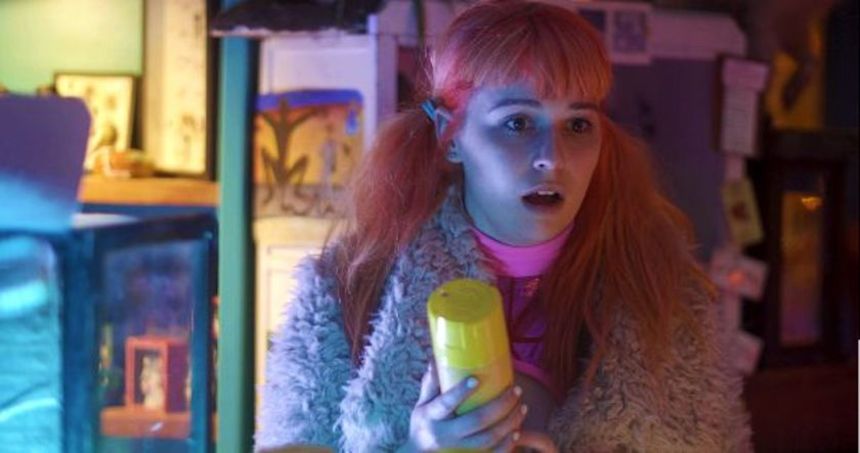Review: HOLY TRINITY, Sly, Subversive Exploration of Queer Spirituality

Twenty-one years ago, a then little-known writer-director, M. Night Shyamalan (Glass, Split, Unbreakable), found the sweetest of hooks for his third, feature-length film, The Sixth Sense: A character who can communicate with the dead (whether they want to or not). Multiple Academy Award nominations and certified box-office gold status later, Shyamalan found his personal brand elevated to stratospheric levels.
His subsequent career may have been filled with a disappointing mix of frequent misses and occasional hits, but that Twilight Zone-inspired premise still retains more than enough juice for other filmmakers to exploit in service of their own singular voice like, for example, Chicago-based writer-director-producer-performer Molly Hewitt and Hewitt’s feature-length debut, Holy Trinity, a one-of-a-kind sex- and kink-positive supernatural comedy.
Set in an alternate universe where a single mega-corporation provides consumers with everything they need or can possibly want, Hewitt opens Holy Trinity with a TV program inside the film (rather than a film-within-a-film), a broad parody of shows like “Long Island Medium,” with Tiamaria Brucetti (Kaycee Conway), a big-haired, long-nailed woman with a heavy Long Island accent and a flair for showmanship convincing an all-too-gullible client of her clairvoyant powers. The brief glimpse of the TV program sets up the central question Holy Trinity asks and answers almost immediately: Can Trinity, huffing room cleaner aerosol, actually hear and/or communicate with the dead?
The short answer: Yes, she can, but as the writer-director, Hewitt spends less time exploring or examining the various complications of Trinity’s extra-sensory powers (that’s saved for the last half-hour) than Trinity’s day-to-day interactions with her longtime lover, Baby (Theo Germaine), the sub to her dom in a BDSM relationship that Hewitt treats matter-of-factly, her occasional clients, and get togethers with roommates and friends from the across the LGBTQ community.
At least initially, Trinity begins to hear the occasional voice, then a few, overlapping voices before ultimately coming face-to-face with the ghostly remains of a young woman who died in a comically tragic — or tragically comic — manner. Once, though, Trinity agrees to act as a go-between for the dead woman and her slightly guilty friends nearby, viral and internet fame follow, leading to the obligatory “blessing or curse” discussion, a new side hustle as a medium for people eager to chat with long-lost loved ones, and the not-unexpected fracturing of Trinity’s relationship with Baby.
From the outside looking in, Trinity and Baby’s relationship may appear unconventional, but from the inside looking out, it’s based on mutual trust and respect. When that trust and respect begins to erode due to Trinity’s newfound fame, their relationship begins to flounder.
For all of Holy Trinity’s bright, gaudy lights and visual extremes (colors, costumes, etc.), at its center, it’s far more conventional than it initially appears. Trinity has to learn to adjust and adapt to her newfound ability without endangering what’s really important to Trinity: Baby and her relationship to Baby. Holy Trinity takes a far more subversive, satirical approach, however, as it follows Trinity along her journey towards self-awareness and the emotional, mental, and physical demands of adulthood, stopping at a meet-and-greet for a kink-filled party with fellow sex workers, a return to Trinity’s Catholic past when she visits a local church for a spiritual chat with an eccentric priest, and finally to a Catholic-themed rave filled with faux-nuns, faux-priests, and faux-popes bursting with bacchanalian, Bunuelian energy (the late Ken Russell, director of the once-banned The Devils, would be proud).
Apart from the heavy lifting involved in writing, directing, and producing (admirable individually and collectively), Hewitt makes for a winning presence onscreen, giving Trinity a mix of positive and not-so-positive qualities, comfortable in her physicality, but uncomfortable in her emotionality, unequal parts self-centered and messy, but always recognizably humane and human.
Hewitt’s upbeat, spirited onscreen presence, along with Mood Killer's (aka Michael Zarowny's) retinal-baking production design and Greg Stephen Reigh neon-soaked cinematography, makes Holy Trinity's occasional longueurs and narrative dead-ends — not atypical for a filmmaker making their feature-length debut — all the more tolerable.
The film is now available to rent/own on digital exclusively through indie distributor Full Spectrum Features.







